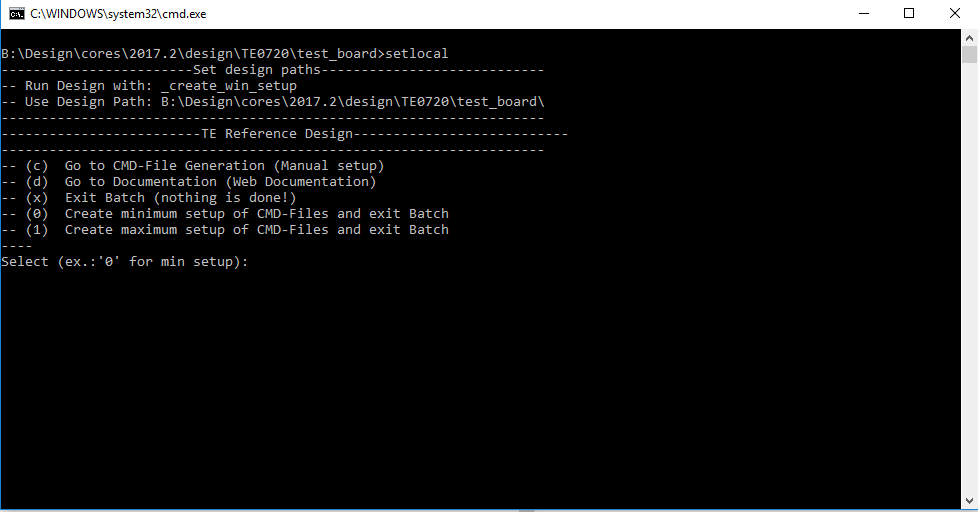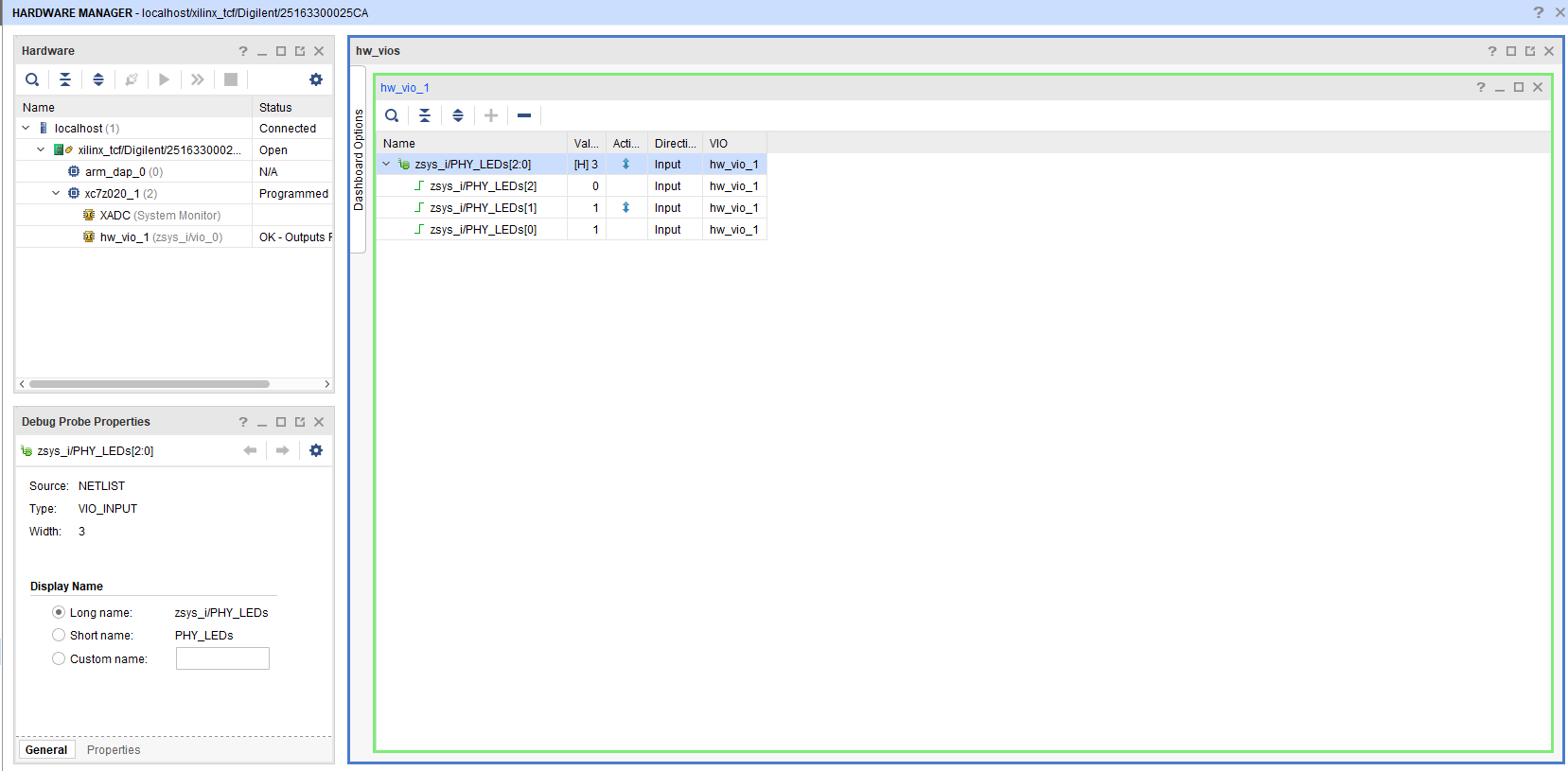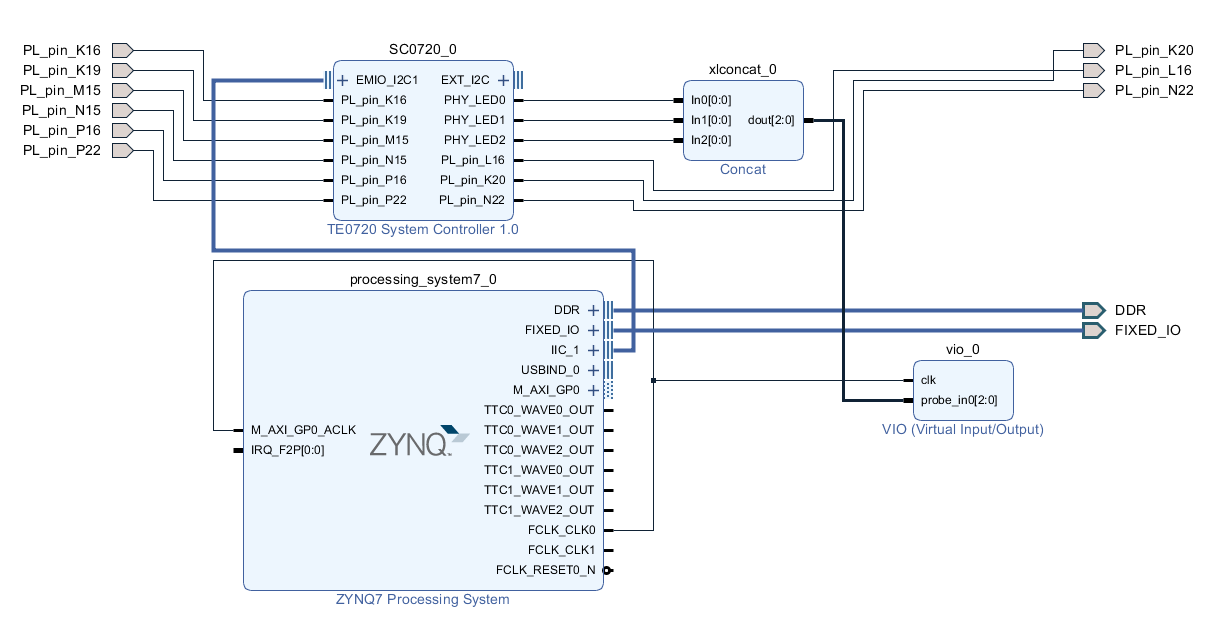<!-- Template Revision 1.0 Basic Notes - export PDF to download, if vivado revision is changed! - Template is for different design and SDSoC and examples, remove unused or wrong description! --> |
Online version of this manual and other related documents can be found at https://wiki.trenz-electronic.de/display/PD/Trenz+Electronic+Documentation |
Table of contents |
<!-- General Design description --> |
Zynq PS Design with Linux for TE0701 with HDMI support.
<!-- Add Basic Key Features of the design (should be tested) --> |
|
<!-- - Add changes from design - Export PDF to download, if vivado revision is changed! --> |
| Date | Vivado | Project Built | Authors | Description |
|---|---|---|---|---|
| 2017-11-20 | 2017.2 | te0720-test_board_noprebuilt-vivado_2017.2-build_05_20171122074701.zip te0720-test_board-vivado_2017.2-build_05_20171122074646.zip | John Hartfiel |
|
<!-- - add known Design issues and general Notes for the current revision --> |
| Issues | Description | Workaround | To be fixed version |
|---|---|---|---|
| No known issues | --- | --- | --- |
<!-- Add needed external Software --> |
| Software | Version | Note |
|---|---|---|
| Vivado | 2017.2 | needed |
| SDK | 2017.2 | needed |
| PetaLinux | 2017.2 | needed |
<!-- Hardware Support --> |
Basic description of TE Board Part Files is available on TE Board Part Files.
Complete List is available on <design name>/board_files/*_board_files.csv
Design supports following modules:
| Module Model | Board Part Short Name | PCB Revision Support | DDR | QSPI Flash | Others | Notes |
|---|---|---|---|---|---|---|
| te0720-03-2if | 2if | REV02, REV03 | 1GB | 32 | ||
| te0720-03-2ifc3 | 2if | REV02, REV03 | 1GB | 32 | 2.5 mm connector | |
| te0720-03-2ifc8 | 2if | REV02, REV03 | 1GB | 32 | 32GB eMMC |
|
| te0720-03-1qf | 1qf | REV02, REV03 | 1GB | 32 | ||
| te0720-03-1cf | 1cf | REV02, REV03 | 1GB | 32 | ||
| te0720-03-2ef | 2ef | REV02, REV03 | 1GB | 32 | ||
| te0720-03-1cr | 1cr | REV02, REV03 | 256MB | 32 | ||
| te0720-03-l1if | l1if | REV02, REV03 | 512MB (L) | 32 | ||
| te0720-03-14s-1c | 14s | REV02, REV03 | 1GB (L) | 32 |
Design supports following carriers:
| Carrier Model | Notes |
|---|---|
| TE0701 |
|
Additional HW Requirements:
| Additional Hardware | Notes |
|---|---|
| USB Cable for JTAG/UART | Check Carrier Board and Programmer for correct type |
<!-- Remove unused content --> |
For general structure and of the reference design, see Project Delivery
| Type | Location | Notes |
|---|---|---|
| Vivado | <design name>/block_design <design name>/constraints <design name>/ip_lib | Vivado Project will be generated by TE Scripts |
| SDK/HSI | <design name>/sw_lib | Additional Software Template for SDK/HSI and apps_list.csv with settings for HSI |
| PetaLinux | <design name>/os/petalinux | PetaLinux template with current configuration |
| Type | Location | Notes |
|---|
<!-- <table width="100%"> <tr> <th>File </th> <th>File-Extension</th> <th>Description </th> </tr> <tr> <td>BIF-File </td> <td>*.bif </td> <td>File with description to generate Bin-File </td> </tr> <tr> <td>BIN-File </td> <td>*.bin </td> <td>Flash Configuration File with Boot-Image (Zynq-FPGAs) </td> </tr> <tr> <td>BIT-File </td> <td>*.bit </td> <td>FPGA Configuration File </td> </tr> <tr> <td>DebugProbes-File </td> <td>*.ltx </td> <td>Definition File for Vivado/Vivado Labtools Debugging Interface </td> </tr> <tr> <td>Debian SD-Image </td> <td>*.img </td> <td>Debian Image for SD-Card </td> </tr> <tr> <td>Diverse Reports </td> <td> --- </td> <td>Report files in different formats </td> </tr> <tr> <td>Hardware-Platform-Specification-Files</td> <td>*.hdf </td> <td>Exported Vivado Hardware Specification for SDK/HSI </td> </tr> <tr> <td>LabTools Project-File </td> <td>*.lpr </td> <td>Vivado Labtools Project File </td> </tr> <tr> <td>MCS-File </td> <td>*.mcs </td> <td>Flash Configuration File with Boot-Image (MicroBlaze or FPGA part only) </td> </tr> <tr> <td>MMI-File </td> <td>*.mmi </td> <td>File with BRAM-Location to generate MCS or BIT-File with *.elf content (MicroBlaze only) </td> </tr> <tr> <td>OS-Image </td> <td>*.ub </td> <td>Image with Linux Kernel (On Petalinux optional with Devicetree and RAM-Disk) </td> </tr> <tr> <td>Software-Application-File </td> <td>*.elf </td> <td>Software Application for Zynq or MicroBlaze Processor Systems </td> </tr> <tr> <td>SREC-File </td> <td>*.srec </td> <td>Converted Software Application for MicroBlaze Processor Systems </td> </tr> </table> --> |
File | File-Extension | Description |
|---|---|---|
| BIF-File | *.bif | File with description to generate Bin-File |
| BIN-File | *.bin | Flash Configuration File with Boot-Image (Zynq-FPGAs) |
| BIT-File | *.bit | FPGA (PL Part) Configuration File |
| DebugProbes-File | *.ltx | Definition File for Vivado/Vivado Labtools Debugging Interface |
| Diverse Reports | --- | Report files in different formats |
| Hardware-Platform-Specification-Files | *.hdf | Exported Vivado Hardware Specification for SDK/HSI and PetaLinux |
| LabTools Project-File | *.lpr | Vivado Labtools Project File |
| OS-Image | *.ub | Image with Linux Kernel (On Petalinux optional with Devicetree and RAM-Disk) |
| Software-Application-File | *.elf | Software Application for Zynq or MicroBlaze Processor Systems |
Reference Design is only usable with the specified Vivado/SDK/PetaLinux/SDx version. Do never use different Versions of Xilinx Software for the same Project.
<!-- Add correct path:https://shop.trenz-electronic.de/en/Download/?path=Trenz_Electronic/TE0803/Reference_Design/2017.1/Starterkit --> |
Reference Design is available on:
<!-- Basic Design Steps Add/ Remove project specific --> |
Reference Design is available with and without prebuilt files. It's recommended to use TE prebuilt files for first lunch. |
Trenz Electronic provides a tcl based built environment based on Xilinx Design Flow.
See also:
The Trenz Electronic FPGA Reference Designs are TCL-script based project. Command files for execution will be generated with "_create_win_setup.cmd" on Windows OS and "_create_linux_setup.sh" on Linux OS.
TE Scripts are only needed to generate the vivado project, all other additional steps are optional and can also executed by Xilinx Vivado/SDK GUI. For currently Scripts limitations on Win and Linux OS see: Project Delivery Currently limitations of functionality

<!-- Description of Block Design, Constrains... BD Pictures from Export... --> |
Check Module and Carrier TRMs for proper HW configuration before you try any design. |
Xilinx documentation for programming and debugging: Vivado/SDK/SDSoC-Xilinx Software Programming and Debugging
Not used on this Example.
<!-- Example: Connect JTAG and power on PCB (if not done) Select correct device and Xilinx install path on "design_basic_settings.cmd" and create Vivado project with "vivado_create_project_guimode.cmd" or open with "vivado_open_project_guimode.cmd", if generated. Type on Vivado Console: TE::pr_program_flash_mcsfile -swapp u-boot Note: Alternative use SDK or setup Flash on Vivado manually Reboot (if not done automatically) --> |
Not used on this Example.
Open Vivado HW-Manager and add VIO signal to dashboard (*.ltx located on prebuilt folder).
PHY LED:

<!-- Description of Block Design, Constrains... BD Pictures from Export... --> |

| Type | Note |
|---|---|
| DDR | --- |
| QSPI | MIO |
| ETH0 | MIO |
| USB0 | MIO |
| SD0 | MIO |
| SD1 | MIO |
| UART0 | MIO |
| UART1 | MIO |
| I2C0 | MIO |
| I2C1 | EMIO |
| GPIO | MIO |
| TTC | EMIO |
# # Common BITGEN related settings for TE0720 SoM # set_property BITSTREAM.GENERAL.COMPRESS TRUE [current_design] set_property CONFIG_VOLTAGE 3.3 [current_design] set_property CFGBVS VCCO [current_design |
# set_property BITSTREAM.CONFIG.UNUSEDPIN PULLUP [current_design] |
# # Constraints for System controller support logic # set_property PACKAGE_PIN K16 [get_ports PL_pin_K16] set_property PACKAGE_PIN K19 [get_ports PL_pin_K19] set_property PACKAGE_PIN K20 [get_ports PL_pin_K20] set_property PACKAGE_PIN L16 [get_ports PL_pin_L16] set_property PACKAGE_PIN M15 [get_ports PL_pin_M15] set_property PACKAGE_PIN N15 [get_ports PL_pin_N15] set_property PACKAGE_PIN N22 [get_ports PL_pin_N22] set_property PACKAGE_PIN P16 [get_ports PL_pin_P16] set_property PACKAGE_PIN P22 [get_ports PL_pin_P22] # # If Bank 34 is not 3.3V Powered need change the IOSTANDARD # set_property IOSTANDARD LVCMOS33 [get_ports PL_pin_P22] set_property IOSTANDARD LVCMOS33 [get_ports PL_pin_P16] set_property IOSTANDARD LVCMOS33 [get_ports PL_pin_N22] set_property IOSTANDARD LVCMOS33 [get_ports PL_pin_N15] set_property IOSTANDARD LVCMOS33 [get_ports PL_pin_M15] set_property IOSTANDARD LVCMOS33 [get_ports PL_pin_L16] set_property IOSTANDARD LVCMOS33 [get_ports PL_pin_K20] set_property IOSTANDARD LVCMOS33 [get_ports PL_pin_K19] set_property IOSTANDARD LVCMOS33 [get_ports PL_pin_K16] |
<!-- optional chapter separate sections for different apps --> |
For SDK project creation, follow instructions from:
TE modified 2017.2 FSBL
Functions:
Changes:
U-Boot.elf is generated with PetaLinux. SDK/HSI is used to generate Boot.bin.
<!-- optional chapter Add "No changes." or "Activate: and add List" --> |
For PetaLinux installation and project creation, follow instructions from:
#include <configs/platform-auto.h> #define UBOOT_ENV_MAGIC 0xCAFEBABE #define UBOOT_ENV_MAGIC_ADDR 0xFFFFFC00 #define UBOOT_ENV_ADDR 0xFFFFFC04 |
/include/ "system-conf.dtsi"
/ {
};
/* default */
/* Flash */
&qspi {
flash0: flash@0 {
compatible = "w25q256";
};
};
/* ETH PHY */
&gem0 {
phy-handle = <&phy0>;
mdio {
#address-cells = <1>;
#size-cells = <0>;
phy0: phy@0 {
compatible = "marvell,88e1510";
device_type = "ethernet-phy";
reg = <0>;
};
};
};
/* USB PHY */
/{
usb_phy0: usb_phy@0 {
compatible = "ulpi-phy";
//compatible = "usb-nop-xceiv";
#phy-cells = <0>;
reg = <0xe0002000 0x1000>;
view-port = <0x0170>;
drv-vbus;
};
};
&usb0 {
dr_mode = "host";
//dr_mode = "peripheral";
usb-phy = <&usb_phy0>;
};
/* I2C need I2C1 connected to te0720 system controller ip */
&i2c1 {
iexp@20 { // GPIO in CPLD
#gpio-cells = <2>;
compatible = "ti,pcf8574";
reg = <0x20>;
gpio-controller;
};
iexp@21 { // GPIO in CPLD
#gpio-cells = <2>;
compatible = "ti,pcf8574";
reg = <0x21>;
gpio-controller;
};
rtc@6F { // Real Time Clock
compatible = "isl12022";
reg = <0x6F>;
};
};
|
Activate:
Activate:
Script App to load init.sh from SD Card if available.
See: \os\petalinux\project-spec\meta-user\recipes-apps\startup\files
<!-- Add Description for other Software, for example SI CLK Builder ... --> |
No additional software is needed.
To get content of older revision got to "Change History" of this page and select older document revision number.
<!-- Generate new entry: 1:add new row below first 2:Copy Page Information Macro(date+user) Preview, Page Information Macro Preview 3.Update Metadate =Page Information Macro Preview+1 --> |
| Date | Document Revision | Authors | Description |
|---|---|---|---|
| 2017-11-20 | v.1 |
| |
| All |